The 10 Healthiest High-Fiber Foods You Can Eat
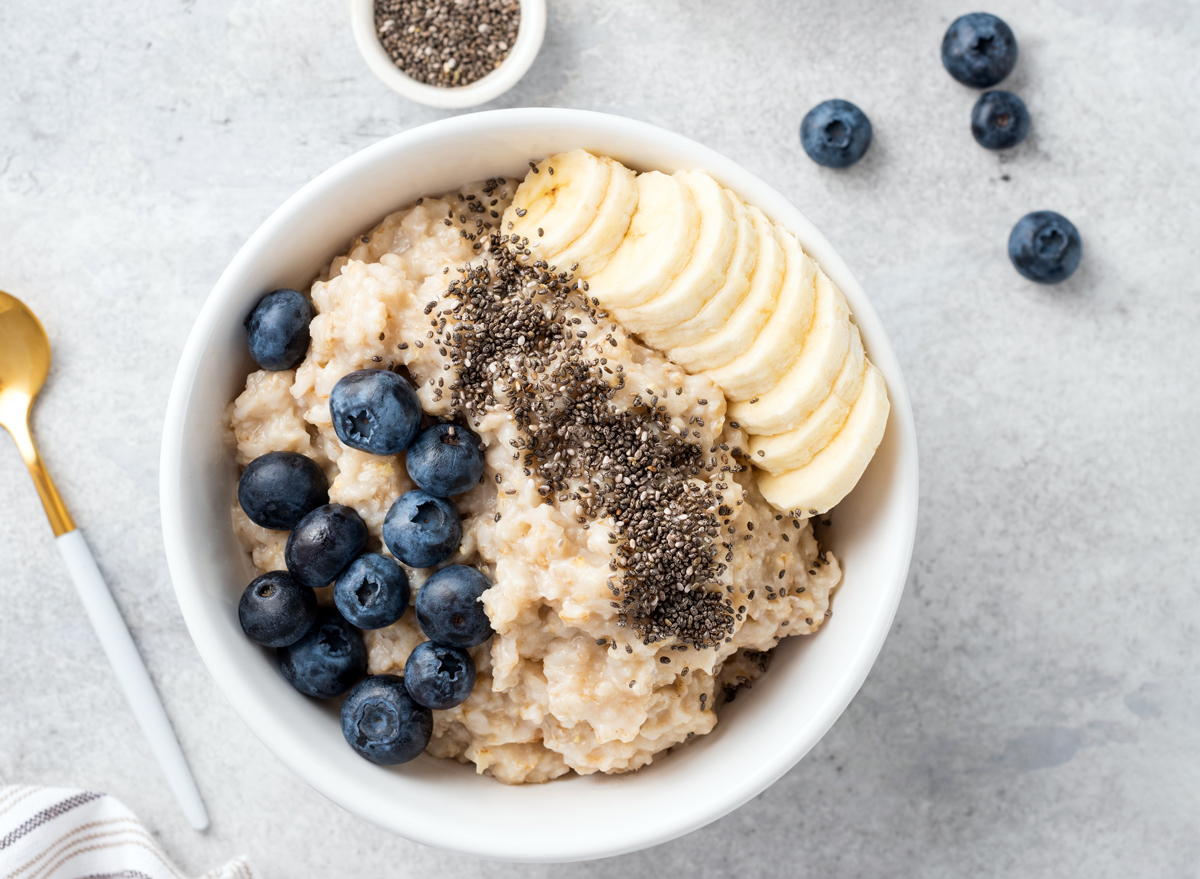
One of the most important nutrients for your health is fiber. But despite this truth, research continues to show that people in the United States aren't getting nearly enough. Not getting enough fiber has now been called "a public health concern," and some studies have even found that there is a link between your fiber intake and mortality. At the bare minimum, it is recommended that women aim for 21-25 grams of fiber a day, while men should aim for 30-38 grams. This may sound like a lot at first, especially if you're not used to focusing on fiber, but if you can find the best high-fiber foods to eat that you enjoy eating and can get excited about, it will be a lot easier to reach these goals.
The health benefits of eating fiber
Before diving into sources of fiber, let's look at the reasons you need this nutrient. According to Amy Goodson, MS, RD, CSSD, LD, eating enough fiber can produce the following potential health benefits:
- Digestive health: There are two types of fiber: soluble and insoluble fiber. Insoluble fiber adds bulk to the stool, promoting regular bowel movements and preventing constipation. Soluble fiber, on the other hand, can help manage diarrhea by absorbing excess water.
- Weight management: High-fiber foods are often lower in calories and take longer to chew, promoting a feeling of fullness, which helps control appetite and contributes to weight management.
- Blood sugar control: Soluble fiber can help regulate blood sugar levels by slowing down the absorption of sugar, which is beneficial for individuals with diabetes or those at risk of developing diabetes.
- Heart health: Fiber has been linked to a reduced risk of heart disease, and soluble fiber helps lower cholesterol levels by binding to cholesterol particles and removing them from the body.
Read on to learn more about some of the healthiest sources of fiber you can eat, so that you can reach your daily fiber goals as well as get a boost of other nutrients like protein, carbohydrates, and important vitamins and minerals. Then check out the 10 Healthiest Sources of Protein You Can Eat.
10 Healthiest Sources of Fiber
The following foods are not only rich in fiber but are also considered healthy because of their abundant nutrient content.
Black beans
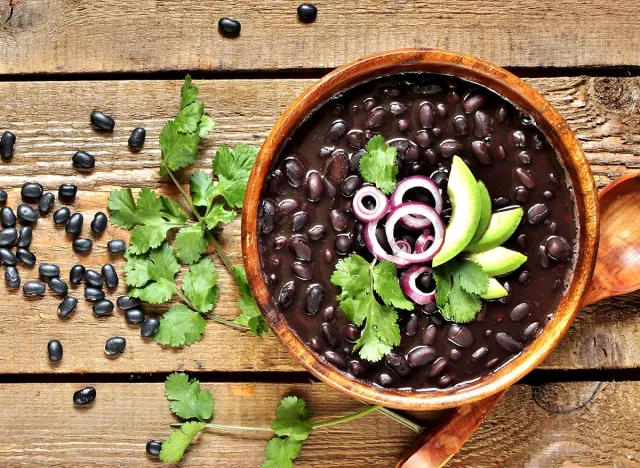
Fiber per 1/2 cup serving: 8.3 grams
Black beans are the way to go when you need a fiber boost. They're delicious, affordable, and can be cooked into a variety of different dishes.
"These beans are rich in both soluble and insoluble fiber, with around 15 grams of fiber per cup (cooked)," says Goodson, "and the fiber in black beans supports digestive health, helps regulate blood sugar levels, and contributes to a lower risk of heart disease."
Goodson adds that on top of providing fiber, "They also provide protein, vitamins, and minerals."
Specifically, a serving of black beans yields over 7 grams of protein and 2.3 grams of iron (13% of the daily value), and it is full of powerful antioxidants, specifically anthocyanins. These antioxidants have been associated with reduced risk of disease and inflammation.
Pistachios
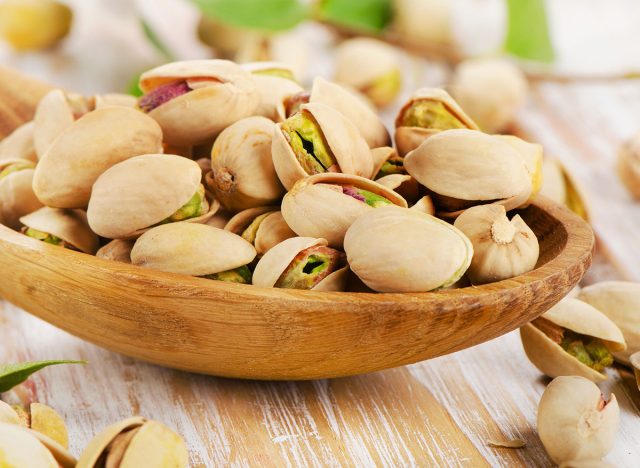
Fiber per 1-ounce serving: 3 grams
Pistachios are one of the healthiest fiber sources you can snack on because "they are not only a natural source of fiber, but they also provide 'good fats' and are a complete source of plant-based protein," says Lauren Manaker, MS, RDN.
The fact that they are a "complete protein" source means they contain all nine essential amino acids that your body needs for protein synthesis, and according to the journal Nutrients, the amino acid composition of pistachios is comparable with both beef and chicken.
Manaker adds that along with fiber and protein, "Pistachios have a very high antioxidant capacity, among the highest when compared to values reported in research of many foods commonly known for their antioxidant capacity, such as blueberries, pomegranates, cherries, and beets."
Lentils (and other pulses)
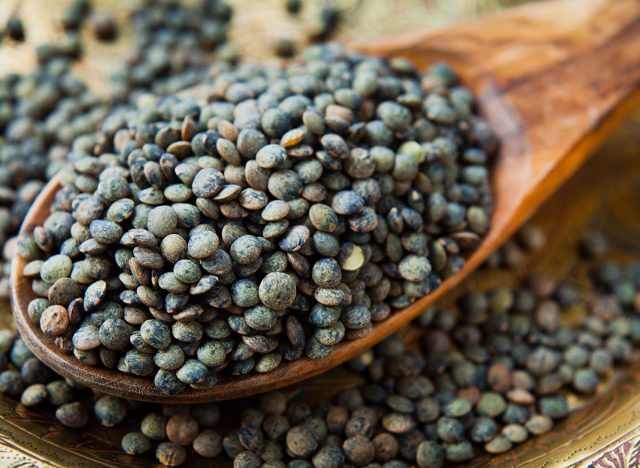
Fiber per 1/2 cup serving of lentils: 7.8 grams
Pulses are a grouping of food that includes beans, lentils, and chickpeas.
"Known for their protein and fiber content, pulses are a key dietary staple in vegetarian and vegan diets, heart-healthy diets, and more," says Manaker. "Pulses are not only nutritious but also sustainable, and rich in important nutrients like fiber, protein, folate, potassium, and iron."
Lentils, specifically, have almost 8 grams of fiber per serving, and research shows that lentils can help prevent high blood pressure and that the polyphenols found in lentils are linked to reducing the risk of chronic disease
To enjoy the benefits of lentils, use them as a base for your favorite protein-packed bowl, or make a simple lentil soup with vegetables and meat.
Avocado
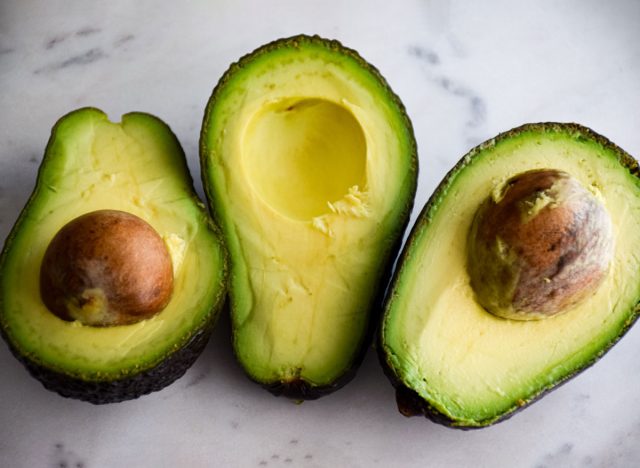
Fiber per 50-gram serving: 3.4 grams
A powerful superfood that works as a spread for toast, a base for guacamole, or a topping for taco night, avocados are rich in a multitude of nutrients and are a healthy source of fiber.
"One avocado contains both soluble and insoluble types of fiber, and unlike many other fruits, avocados are quite low in sugar," says Manaker.
Avocados are also known to help support gut health, and a 2021 study published in the Journal of Nutrition found that avocado consumption improved gut health and bacterial diversity in participants.
Goodson also includes avocados in her list of healthiest sources of fiber, because "The fiber in avocados promotes a feeling of fullness and supports digestive health, and they also contain heart-healthy monounsaturated fats, vitamins, and minerals."
Broccoli
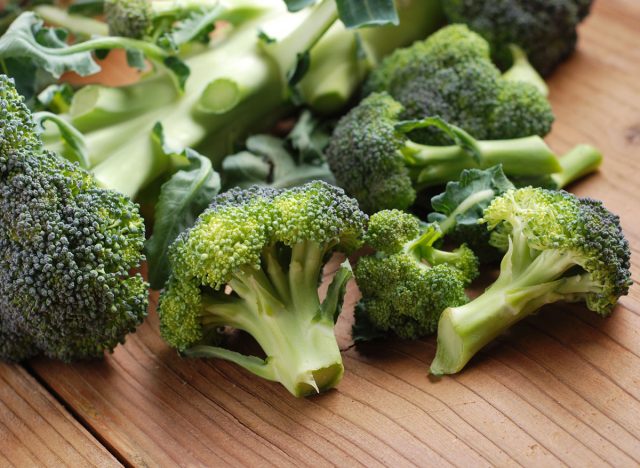
Fiber per 1 cup serving: 5.1 grams
According to Manaker, broccoli is one of the healthiest fiber sources out there.
"For starters, the fiber in broccoli exists in both soluble and insoluble forms, each performing distinct roles in digestive health," she says. Beyond that, "Broccoli is packed with a wealth of other nutrients that contribute to overall health."
One cup of broccoli provides about 133% of the daily value of vitamin C, "A potent antioxidant that aids in boosting immunity and promoting skin health," says Manaker.
Broccoli also contains about 183% of your daily vitamin K value, which is a vitamin "crucial for bone health and normal blood clotting," says Manaker.
Oats
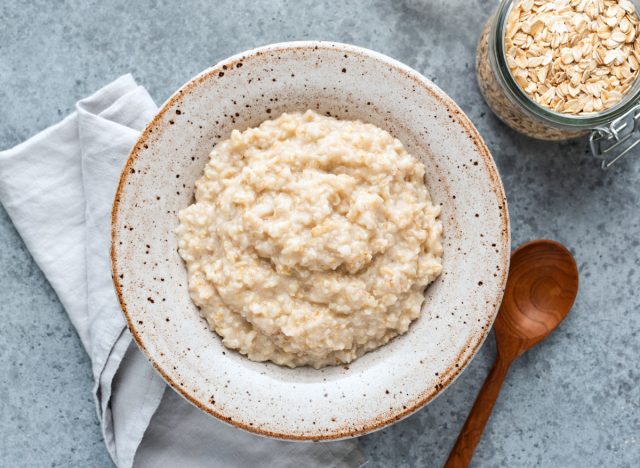
Fiber per 1/2 cup serving: 4 grams
Oats, like most types of whole grains, are a great source of fiber, and according to Goodson, they are specifically a good source of soluble fiber.
"The beta-glucans in oats have been linked to reduced cholesterol levels, making them beneficial for heart health," says Goodson. "Oats also contribute to a feeling of fullness and provide a good source of energy."
The benefits don't stop there, though. Research has also linked oat consumption to a reduced risk of things like cardiovascular disease and inflammation, while also providing the body with helpful antioxidants.
Whole grain bread
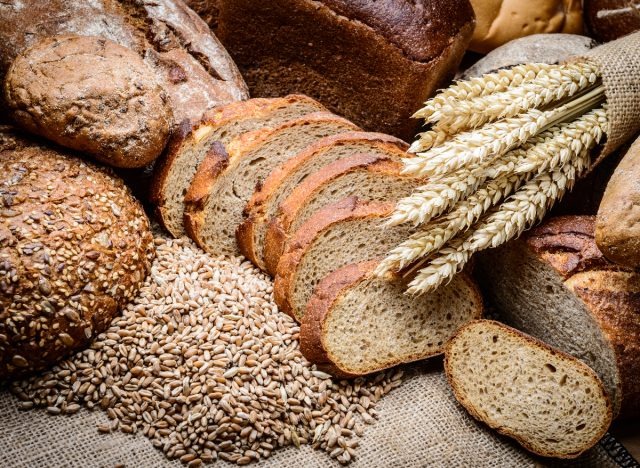
Fiber per slice of whole grain bread: 3 grams
Despite the messages you may have grown up hearing, bread isn't bad. Refined carbohydrates like white bread don't offer the body any nutritional value, but whole grain bread has been proven to offer a variety of health benefits—and it is a healthy source of fiber, too.
Whole grain bread falls into the general category of "whole grains," and according to Manaker, "Whole grains are packed with important nutrients like fiber, protein, B vitamins, antioxidants, and trace minerals (iron, zinc, copper, and magnesium)."
She also adds that "A diet rich in whole grains has been shown to reduce the risk of heart disease, type 2 diabetes, obesity, and certain types of cancer."
So, don't hesitate to make yourself that delicious sandwich for lunch or that avocado toast for breakfast, and if you want the fiber boost and health benefits, choose a slice of whole grain bread.
Blueberries
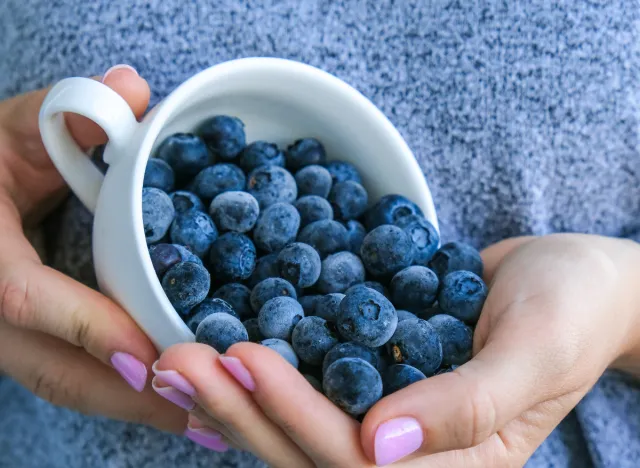
Fiber per 1 cup serving: 3.6 grams
If you want a fiber boost that has a sweeter side, a serving of blueberries will do the trick.
"Blueberries are a delicious and nutritious fruit, providing 4 grams of fiber per cup, and the fiber in blueberries supports digestive health and helps regulate blood sugar levels," says Goodson.
Along with being a source of fiber, "Blueberries are also rich in antioxidants, particularly anthocyanins, which have been associated with cognitive benefits and overall well-being," Goodson adds.
Research also shows that consistent consumption of these blueberry Anthocyanins may help with weight management and may also be linked to a reduced risk of cardiovascular disease and type 2 diabetes.
Chia seeds
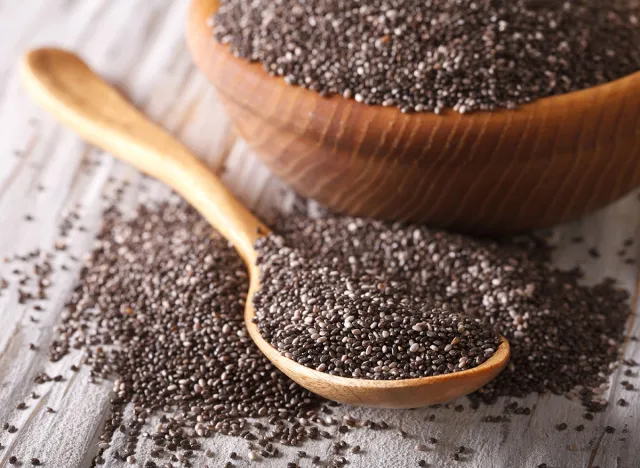
Fiber per 1-ounce serving (2 tbsp): 9.6 grams
When you need a quick and easy boost of soluble fiber, Goodson recommends turning to chia seeds.
"The soluble fiber in chia seeds forms a gel-like substance when mixed with water, promoting a feeling of fullness and aiding in digestion," says Goodson. "Additionally, they contain omega-3 fatty acids, which are beneficial for heart health."
You can throw chia seeds into water, yogurt, milk, smoothies, etc., but Harvard Health advises that you give these seeds time to absorb the liquid and soften, rather than eating them dry, because dry chia seeds may disturb your gut health and cause constipation or discomfort.
Quinoa
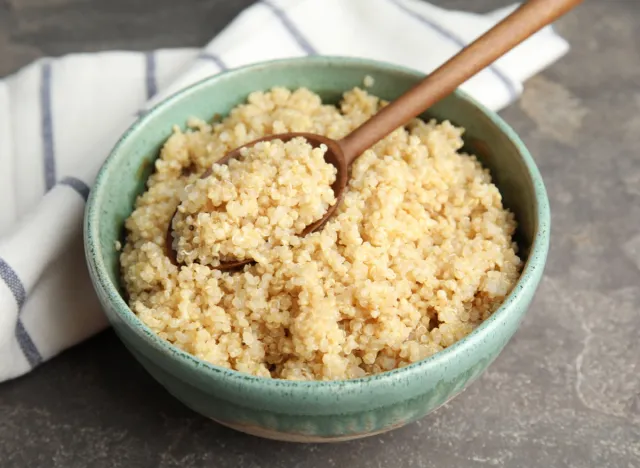
Fiber per 1 cup serving: 5.2 grams
When it comes to a healthy source of fiber, you need to try quinoa. Not only does a 1-cup serving of cooked quinoa provide over 5 grams of soluble and insoluble fiber, but according to Goodson, "Quinoa is a complete protein source and contains essential amino acids."
She adds that "the fiber content of quinoa also contributes to digestive health, helps regulate blood sugar, and can assist in weight management."
Quinoa also contains plant compounds that act as antioxidants, and research has shown these compounds to have anti-inflammatory effects as well.
Many people enjoy quinoa as a rice replacement in their favorite dishes, but you can also add quinoa to a salad or cook it with milk, maple, and fruit for a sweet breakfast treat.
- Source: https://www.ncbi.nlm.nih.gov/pmc/articles/PMC6124841/
- Source: https://www.ncbi.nlm.nih.gov/pmc/articles/PMC7589116/
- Source: https://www.mayoclinic.org/healthy-lifestyle/nutrition-and-healthy-eating/in-depth/high-fiber-foods/art-20050948#:~:text=Women%20should%20try%20to%20eat,It%20can%20vary%20among%20brands.
- Source: https://www.ncbi.nlm.nih.gov/pmc/articles/PMC5731843/
- Source: https://fdc.nal.usda.gov/fdc-app.html#/food-details/175188/nutrients
- Source: https://ods.od.nih.gov/factsheets/Iron-HealthProfessional/#:~:text=The%20DV%20for%20iron%20is,contribute%20to%20a%20healthful%20diet.
- Source: https://www.ncbi.nlm.nih.gov/pmc/articles/PMC6152262/
- Source: https://www.ncbi.nlm.nih.gov/pmc/articles/PMC5613902/
- Source: https://fdc.nal.usda.gov/fdc-app.html#/food-details/170184/nutrients
- Source: https://www.ncbi.nlm.nih.gov/pmc/articles/PMC10181398/#:~:text=Pistachio%20nuts%20are%20a%20complete,7.9%20g%2F100%20g).
- Source: https://www.mdpi.com/2072-6643/14/15/3002
- Source: https://fdc.nal.usda.gov/fdc-app.html#/food-details/172421/nutrients
- Source: https://www.cambridge.org/core/journals/british-journal-of-nutrition/article/lentilbased-diets-attenuate-hypertension-and-largeartery-remodelling-in-spontaneously-hypertensive-rats/B956070F075E0E1F78B98CE8101C4B9A
- Source: https://www.ncbi.nlm.nih.gov/pmc/articles/PMC5713359/
- Source: https://fdc.nal.usda.gov/fdc-app.html#/food-details/171706/nutrients
- Source: https://www.ncbi.nlm.nih.gov/pmc/articles/PMC8030699/
- Source: https://fdc.nal.usda.gov/fdc-app.html#/food-details/168510/nutrients
- Source: https://www.mayoclinic.org/healthy-lifestyle/nutrition-and-healthy-eating/expert-answers/vitamin-c/faq-20058030#:~:text=An%20orange%20or%20a%20cup,is%202%2C000%20mg%20a%20day.
- Source: https://www.ncbi.nlm.nih.gov/pmc/articles/PMC5579659/
- Source: https://www.ncbi.nlm.nih.gov/pmc/articles/PMC6955144/#:~:text=Although%20known%20for%20its%20importance,markers%2C%20and%20regulating%20bone%20reabsorption.
- Source: https://fdc.nal.usda.gov/fdc-app.html#/food-details/173904/nutrients
- Source: https://www.ncbi.nlm.nih.gov/pmc/articles/PMC8625765/
- Source: https://www.ncbi.nlm.nih.gov/pmc/articles/PMC5310957/
- Source: https://fdc.nal.usda.gov/fdc-app.html#/food-details/171711/nutrients
- Source: https://www.ncbi.nlm.nih.gov/pmc/articles/PMC8234025/
- Source: https://www.ncbi.nlm.nih.gov/pmc/articles/PMC7442370/
- Source: https://fdc.nal.usda.gov/fdc-app.html#/food-details/170554/nutrients
- Source: https://www.hsph.harvard.edu/nutritionsource/food-features/chia-seeds/#:~:text=Because%20they%20quickly%20swell%20after,dry%20chia%20seeds%20by%20themselves.
- Source: https://fdc.nal.usda.gov/fdc-app.html#/food-details/168917/nutrients
- Source: https://www.hsph.harvard.edu/nutritionsource/food-features/quinoa/#:~:text=Quinoa%20and%20Health&text=One%20cup%20cooked%20provides%20about,cannot%20make%20on%20their%20own.
- Source: https://www.ncbi.nlm.nih.gov/pmc/articles/PMC6651730/









